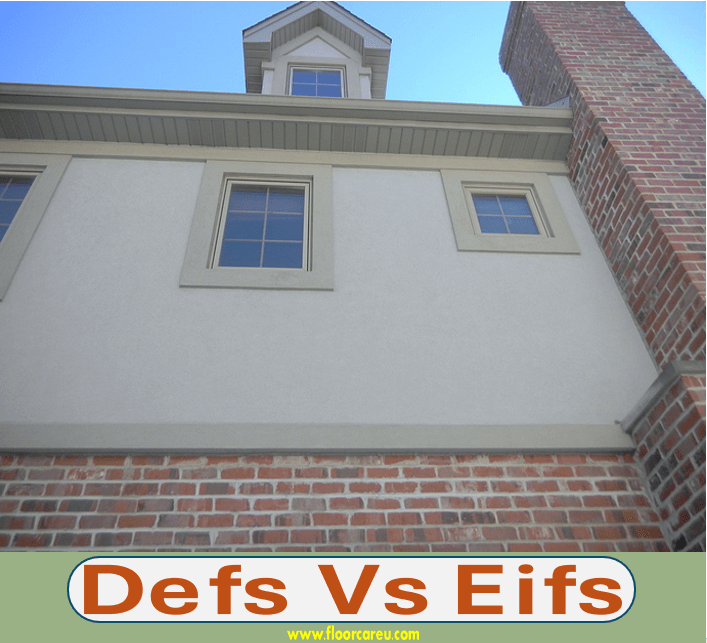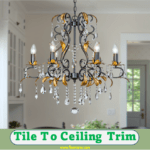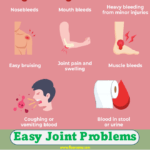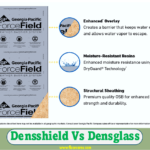Defs Vs Eifs: EIFS stands for Exterior Insulation Finish Systems, while DEFS refers to Direct-Applied Exterior Finish Systems. EIFS is a multi-layered exterior finish, also known as synthetic stucco.
Exterior Insulation Finish Systems (EIFS) and Direct-Applied Exterior Finish Systems (DEFS) are popular building systems used for exterior finishes. EIFS, also called synthetic stucco, consists of a multi-layered finish that offers insulation properties, whereas DEFS directly applies the exterior finish without the rigid expanded polystyrene foam layer.
Understanding the differences between EIFS and DEFS is crucial for architects, contractors, and building owners to decide on the most suitable exterior finish for their projects. Let’s delve deeper into the contrasting features, advantages, and drawbacks of EIFS and DEFS to help you choose the right system for your construction needs.
Understanding Eifs
EIFS, short for Exterior Insulation Finish Systems, is a multi-layered exterior finish also known as Synthetic Stucco, Dryvit, Styrofoam Stucco, and Direct-Applied Finish System (DAFS).
- Pros: Provides excellent insulation, versatile design options, and lightweight construction.
- Cons: Vulnerable to water damage, requires meticulous application, and limited impact resistance.
| Cladding Option | Advantages |
|---|---|
| Fiber Cement | Offers superior weather protection, moisture resistance, and style compared to EIFS. |

Exploring Defs
Exploring DEFS and EIFS reveals their differences: EIFS, or Synthetic Stucco, features multiple layers for exterior finish, while DEFS, or Direct-Applied Finish System, applies Exterior Insulation Finish Systems directly to sheathing without foam layers. Each system offers unique advantages for building exteriors.
Overview Of Defs
Direct-Applied Exterior Finish System (DEFS) is an alternative to Exterior Insulated and Finish Systems (EIFS). It involves the application of finish systems directly to sheathing without the rigid expanded polystyrene foam layer used in EIFS. DEFS solutions are designed to provide weather protection and moisture resistance while offering a seamless and aesthetically pleasing exterior finish.
Comparison Between Defs And Eifs
When comparing DEFS and EIFS, several differences become apparent. While EIFS is a multi-layered exterior finish system, DEFS directly applies the finish system to the sheathing. Both systems aim to provide weather protection and moisture resistance, but their application methods and materials vary significantly. Furthermore, EIFS typically involves insulation boards affixed to a substrate with water-resistant barriers, while DEFS does not incorporate the same insulation board layer.
Defs Vs. Eifs – Exterior Inspections
Ensuring the integrity and functionality of exterior finishes is crucial in both DEFS and EIFS. However, exterior inspections for DEFS may require a different approach due to the absence of the rigid expanded polystyrene foam layer in EIFS. Identifying materials and conducting a detailed visual examination of the layers is essential to identify an EIFS/stucco system properly. At the same time, DEFS inspections may focus more on the direct application and finish systems to the sheathing.
Defs In Detail
DEFS, or Direct-Applied Exterior Finish System, is an alternative to EIFS that applies the exterior finish directly to the sheathing without the expanded polystyrene foam layer. Unlike typical EIFS systems, DEFS does not use insulation boards and is not considered EIFS by the North American standard.
For those looking for a different approach to exterior cladding, DEFS may offer a unique solution.
The Direct-Applied Exterior Finish System (DEFS) is a variation of the popular Exterior Insulation Finish Systems (EIFS). Unlike EIFS, DEFS does not utilize a rigid expanded polystyrene foam layer. Instead, DEFS directly applies the EIFS lamina to the sheathing, creating a simplified system. This alternative method still provides the benefits of insulation and finish systems while eliminating the need for additional layers.
Direct-applied Exterior Finish System
The Direct-Applied Exterior Finish System, or DEFS, offers a straightforward and efficient approach to exterior finishes. By applying the EIFS lamina directly to the sheathing, DEFS eliminates the need for a separate foam layer. This results in a simplified process that saves time and materials without compromising on the performance and aesthetic beauty it provides.
Difference Between Defs And Eifs
While DEFS and EIFS share similarities in terms of providing insulation and a finished exterior, there are distinct differences between the two systems:
- DEFS does not use a rigid expanded polystyrene foam layer, whereas EIFS does.
- DEFS applies the EIFS lamina directly to the sheathing, eliminating the need for an additional layer.
- DEFS offers a simplified and streamlined process compared to EIFS.
- DEFS can be a cost-effective alternative for projects looking for the benefits of EIFS without the need for an extra foam layer.
Defs Vs. Eifs – What To Consider
When deciding between DEFS and EIFS, it’s essential to consider several factors:
- Project requirements: Assess your project’s specific needs and determine if the simplified DEFS process aligns with your goals.
- Budget: Evaluate your budget and determine if DEFS provides a cost-effective solution without compromising performance.
- Design considerations: Consider your project’s desired aesthetic and architectural style and determine if either system better suits your design needs.
- Timeframe: Evaluate the project timeline and determine if the simplified DEFS process can help expedite the construction process.
- Local building codes and regulations: Ensure that both DEFS and EIFS comply with your area’s building codes and regulations.
By carefully considering these factors, you can decide whether DEFS or EIFS is the right choice for your project’s exterior finish system.
Case Studies And Examples
DEFS (Direct Applied Finish Systems) is an alternative to EIFS (Exterior Insulation Finish Systems) and offers a multi-layered exterior finish. DEFS provides weather resistance, moisture protection, and style that other cladding options cannot match.
Defs Application In Real Projects
DEFS (Direct Applied Exterior Finish Systems) is an innovative EIFS (Exterior Insulation Finish Systems) application that offers several advantages in real construction projects. One successful case study is renovating a downtown Austin, Texas commercial building. The building’s exterior was outdated and lacked energy efficiency.
By implementing DEFS, the building achieved improved insulation, enhanced aesthetic appearance, and higher thermal performance.
Another notable example is a residential project in the suburbs of Austin. The homeowners wanted to increase the curb appeal of their home and lower their energy bills. DEFS provided a durable and visually appealing finish that transformed the house’s look and significantly reduced energy consumption. DEFS demonstrated its versatility and effectiveness in meeting the client’s needs in both cases. The direct application of the exterior finish system ensured a seamless integration with the existing structure, resulting in a flawless finished product.
Success Stories Of Eifs Applications
EIFS has been widely adopted in various construction projects, leading to numerous success stories. One noteworthy example is the renovation of a commercial office building in New York City. Using EIFS, the old, worn-out exterior was transformed into an attractive modern facade, rejuvenating the building’s appearance and improving its energy efficiency.
Another remarkable success story is the application of EIFS in high-rise residential towers in Los Angeles. These buildings faced significant heat gain due to their large windows and exposed facades. Using EIFS, the developers could enhance the buildings’ thermal performance and reduce energy consumption. The EIFS system also provided effective moisture management, ensuring long-term durability. Challenges Faced with Both Systems While DEFS and EIFS offer numerous benefits, they also come with challenges. Two common challenges faced by both systems are:
1. Moisture management: Proper moisture management is crucial to prevent damage to the building envelope. DEFS and EIFS require careful installation and regular maintenance to ensure that moisture is effectively managed and prevented from seeping into the structure.
2. Durability in extreme weather conditions: Buildings are exposed to weather conditions, such as heavy rain, extreme temperatures, and strong winds. DEFS and EIFS must be designed and installed to withstand these conditions, ensuring long-term durability. In conclusion, DEFS and EIFS have their unique strengths and applications. By looking at real case studies and success stories, it becomes evident that both systems can deliver outstanding energy efficiency, aesthetics, and functionality results.
However, to ensure the systems’ longevity, it is important to address the challenges associated with moisture management and durability.
Tips For Successful Implementation
When considering the successful implementation of DEFS vs. EIFS, thoroughly understand the differences between the two systems and their specific requirements for installation and maintenance. Seek expert guidance and stay updated with industry best practices to ensure a smooth and effective implementation.
Tips for Successful Implementation The successful implementation of Def and EIFS systems is crucial for the integrity and longevity of exterior finishes. By following best practices, key strategies, and regular maintenance, these systems’ effective installation and maintenance can be ensured. These guidelines can significantly impact the performance and aesthetics of the building exterior. Best Practices for EIFS Installation When installing EIFS, adherence to best practices is critical for a durable and attractive finish. The following guidelines are essential for successful EIFS installation:
1. Proper Surface Preparation: Before applying the system, ensure the substrates are clean, dry, and free from contaminants.
2. Quality Insulation: Utilize high-quality insulation materials to enhance energy efficiency and exterior protection.
3. Skilled Application: Employ experienced and trained professionals to apply the EIFS layers to ensure a seamless finish accurately. Key Strategies for DEFS Usage For optimal performance of
Direct Applied Finish Systems (DAFS), the following key strategies are vital:
1. Effective Material Selection: Choose high-quality materials compatible with the substrate and climate conditions to prevent potential issues.
2. Precise Application Techniques: Use proper application techniques and equipment to ensure even and consistent coverage of the DEFS layers.
3. Quality Control: Implement thorough quality checks throughout the installation process to promptly detect and address any issues.
Importance of Regular Maintenance Regular maintenance is essential for the longevity and performance of both Def and EIFS exteriors. This includes:
1. Inspections: Regularly inspect the exterior finish for any signs of damage or deterioration, addressing any issues promptly to prevent further damage.
2. Cleaning and Repairs: Clean the surface according to the manufacturer’s recommendations and perform repairs as needed to prevent moisture intrusion and maintain its visual appeal.
3. Professional Assistance: Utilize professional services for comprehensive inspections and necessary repairs to ensure the exterior finish’s long-term stability and visual appeal. Adhering to these tips and strategies will contribute to successful Def and EIFS implementation, ensuring durability, aesthetic appeal, and overall performance of the exterior finishes.

Frequently Asked Questions On Defs Vs Eifs
What Is The Difference Between Eifs And Dafs?
EIFS (Exterior Insulation Finish Systems) is synthetic stucco with a multi-layered exterior finish. DAFS, or Direct Applied Finish System, is another term for EIFS.
What Are The 2 Types Of Eifs Systems?
EIFS systems come in two types: barrier wall systems and wall drainage systems for water resistance.
What Is The Downside Of Eifs?
EIFS can be prone to moisture problems and can be difficult to repair. Over time, it may become a breeding ground for mold and mildew.
What Is Alternative To Eifs?
Fiber cement cladding is an alternative to EIFS. It offers weather protection, moisture resistance, and style. It is a superior option compared to EIFS and other cladding products.
What Is The Difference Between Eifs And Dafs?
EIFS (Exterior Insulation Finish Systems), also known as synthetic stucco, is a multi-layered exterior finish. It is also known as Synthetic Stucco, Dryvit, Styrofoam Stucco, and Direct-Applied Finish System (DAFS).
What Is The Downside Of Eifs?
EIFS, or Exterior Insulation Finish Systems, have the potential for moisture issues and can be susceptible to water penetration if not properly installed and maintained.
Conclusion
Understanding the key differences between DEFS and EIFS is crucial for making informed decisions about exterior finishes. While EIFS offers aesthetic appeal, DEFS provides durability and impact resistance. Both systems have advantages and limitations, so weighing the factors that matter most for your specific project is essential.
Making the right choice can ensure a long-lasting and visually appealing exterior for your building.


